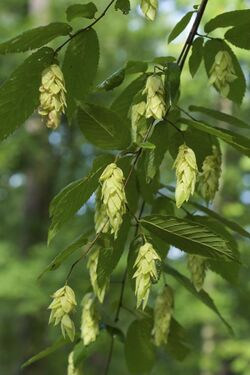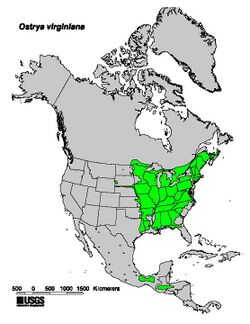Biology:Ostrya virginiana
| American hophornbeam | |
|---|---|

| |
| A hophornbeam branch with the characteristic hop-resembling fruits[1] in early summer | |
| Scientific classification | |
| Kingdom: | Plantae |
| Clade: | Tracheophytes |
| Clade: | Angiosperms |
| Clade: | Eudicots |
| Clade: | Rosids |
| Order: | Fagales |
| Family: | Betulaceae |
| Genus: | Ostrya |
| Species: | O. virginiana
|
| Binomial name | |
| Ostrya virginiana (Mill.) K.Koch
| |

| |
| Generalized native range | |
| Synonyms[3] | |
| |
Ostrya virginiana, the American hophornbeam, is a species of Ostrya native to eastern North America, from Nova Scotia west to southern Manitoba and eastern Wyoming, southeast to northern Florida and southwest to eastern Texas .[4] Populations from Mexico and Central America are also regarded as the same species, although some authors prefer to separate them as a distinct species, Ostrya guatemalensis.[3] Other names include eastern hophornbeam, hardhack (in New England), ironwood, and leverwood.[5][6]
Description
Ostrya virginiana (American hophornbeam) is a small deciduous understory tree growing to 18 m (59 ft) tall and 20–50 centimetres (8–20 in) trunk diameter. The bark is brown to gray-brown, with narrow shaggy plates flaking off, while younger twigs and branches are smoother and gray, with small lenticels.[5][7] Very young twigs are sparsely fuzzy to thickly hairy; the hairs (trichomes) drop off by the next year.[8]
The leaves are ovoid-acute, 5–13 cm (2–5 in) long and 4–6 cm (1 1⁄2–2 1⁄4 in) broad, pinnately veined, with a doubly serrated margin. The upper surface is mostly hairless, while the lower surface is sparsely to moderately fuzzy (rarely densely hairy).[5][7]
The flowers are catkins (spikes) produced in early spring at the same time as the new leaves appear. The staminate (male) catkins are 2–5 cm (3⁄4–2 in) long,[5] and arranged in groups of 1–4.[7] The pistillate (female) catkins are 8–15 mm (5⁄16–19⁄32 in) long, containing 10–30 flowers each.[5]
Pollinated female flowers develop into small nutlets 3–5 mm (1⁄8–3⁄16 in) long fully enclosed in a papery sac-shaped involucre 10–18 mm (3⁄8–11⁄16 in) long and 8–10 mm (5⁄16–3⁄8 in) wide.[5] The involucre changes from greenish-white to dull brown as the fruit matures.[7]
American hophornbeam is similar to its close relative American hornbeam (Carpinus caroliniana), which can be distinguished by its smooth bark and nutlets enclosed in open, three-lobed bracts.[7]
Two trees in winter with some dried leaves still hanging on their branches (marcescence)
Subdivisions
There are two subspecies:
- Ostrya virginiana subsp. guatemalensis (H.J.P.Winkl.) A.E.Murray – central and southern Mexico, Guatemala, Honduras, El Salvador[9]
- Ostrya virginiana subsp. virginiana – eastern half of United States, eastern Canada
Populations along the Atlantic coast have slightly smaller leaves, and are sometimes separated as O. virginiana var. lasia Fernald.[5]
Habitat and ecology
In temperate areas of the US and Canada, Ostrya virginiana is found in lowland and foothill forests, where it is predominantly an understory tree.[2]
In Mexico and Central America, Ostrya virginiana is found in cloud forests and humid portions of mid-elevation oak, pine–oak, and pine forests between 1200 and 2800 meters elevation.[10]
The buds and catkins are important source of winter food for some birds, notably ruffed grouse (Bonasa umbellus).[7] Additionally, the nutlets and buds are eaten by birds, deer, and rabbits.[1]
Uses
It is grown as an ornamental plant and is sometimes used as a street tree.
Its wood is very resilient and is valued for making tool handles and fence posts.
Being a diffuse porous hardwood and having extremely high density and resistance to compression, it is an excellent material for the construction of wooden longbows.
References
- ↑ Jump up to: 1.0 1.1 Little, Elbert L. (1980). The Audubon Society Field Guide to North American Trees: Eastern Region. New York: Knopf. p. 374. ISBN 0-394-50760-6.
- ↑ Jump up to: 2.0 2.1 Stritch, L.; Shaw, K.; Roy , S.; Wilson, B. (2014). "Ostrya virginiana". IUCN Red List of Threatened Species 2014: e.T194540A2346581. doi:10.2305/IUCN.UK.2014-3.RLTS.T194540A2346581.en. https://www.iucnredlist.org/species/194540/2346581. Retrieved 19 November 2021.
- ↑ Jump up to: 3.0 3.1 "Ostrya virginiana". World Checklist of Selected Plant Families (WCSP). Royal Botanic Gardens, Kew. http://wcsp.science.kew.org/qsearch.do?page=quickSearch&plantName=Ostrya%2Bvirginiana.
- ↑ "Ostrya virginiana", County-level distribution map from the North American Plant Atlas (NAPA) (Biota of North America Program (BONAP)), 2014, http://bonap.net/MapGallery/County/Ostrya%20virginiana.png
- ↑ Jump up to: 5.0 5.1 5.2 5.3 5.4 5.5 5.6 Furlow, John J. (1997), "Ostrya virginiana", in Flora of North America Editorial Committee, Flora of North America North of Mexico (FNA), 3, New York and Oxford, http://www.efloras.org/florataxon.aspx?flora_id=1&taxon_id=233500839
- ↑ Nelson Sutherland, C.H. (2008). Catálogo de las plantes vasculares de Honduras. Espermatofitas: 1-1576. SERNA/Guaymuras, Tegucigalpa, Honduras.
- ↑ Jump up to: 7.0 7.1 7.2 7.3 7.4 7.5 Hilty, John (2016). "Hop Hornbeam (Ostrya virginiana)". http://www.illinoiswildflowers.info/trees/plants/hop_hornbeam.htm.
- ↑ Chayka, Katy; Dziuk, Peter (2016), Ostrya virginiana (Ironwood), https://www.minnesotawildflowers.info/tree/ironwood
- ↑ Whittemore, Alan, "Ostrya virginiana", Flora Mesoamericana, Missouri Botanical Garden, http://www.tropicos.org/Name/3600027?projectid=3
- ↑ Mario González-Espinosa, Jorge A. Meave, Francisco G. Lorea-Hernández, Guillermo Ibarra-Manríquez and Adrian C. Newton, eds (2011). The Red List of Mexican Cloud Forest Trees. Fauna & Flora International, Cambridge, UK. 2011. ISBN:9781903703281
- Metzger, F. T. (1990), Hardwoods, 2, Washington, D.C.: United States Forest Service (USFS), United States Department of Agriculture (USDA), https://srs.fs.usda.gov/pubs/misc/ag_654/volume_2/ostrya/virginiana.htm
External links
- Bioimages: Ostrya virginiana.
- University of Wisconsin – Green Bay. Trees of Wisconsin. Ostrya virginiana.
- Virginia Tech Dendrology. Ostrya virginiana Fact Sheet.
- University of Connecticut. Plants Database. Ostrya virginiana.
- Trees, Shrubs, and Woody Vines of North Carolina. Hophornbeam (Ostrya virginiana).
- Yale University. Cyber Flora. Ostrya virginiana.
Wikidata ☰ Q1489573 entry
 |







